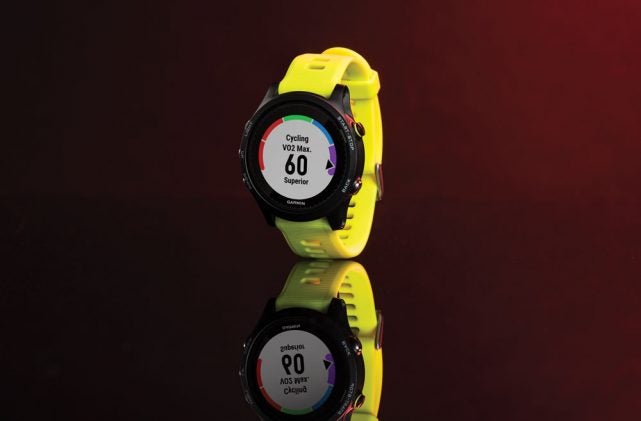3 Months Later: Extended Garmin Forerunner 935 Test

Photo: Oliver Baker
Released in March, the new Garmin Forerunner 935 was a huge update from the 735XT. Adding WiFi capabilities and a barometric altimeter alongside Garmin’s new “Running Dynamics Pod,” this watch veers more towards a fully-functional computer than a simple smart device. Boasting a gorgeous 64-color display, the 935 more closely mirrors Garmin’s Fenix than any previous iterations of the Forerunner.
After three months and six days/week of use, we’ve given the 935 our seal of approval. Read below to see why we loved Garmin’s latest offering.
Our testers put the 935 to work, swimming, biking, running and racing with the watch. We loved the battery life—which Garmin claims to go for 24 hours in GPS mode between charges—and found that it would last for roughly for a week of wear and workouts without plugging in. In fact that lack of wires was one of our testers’ favorite things—we loved the 935’s wireless ability to auto-upload workouts into online programs like Strava. Once in Bluetooth range of a smartphone, activities are uploaded in seconds.
We were also incredibly impressed with the pre-programmed laps for multisport events. One big difference we noticed between the 935 and its older, grayer cousin, the 910, was that the older watch would not auto-upload each leg of a tri into Strava as separate activities. The 910 would simply send a race in “Triathlon Mode” and needed to be split manually while the 935 automatically takes care of everything.
We also loved the manual yardage input for swim drills. Our testers wouldn’t even use their old Garmins in the pool because they never recorded kick sets. The new 935 has a drill feature so swimmers can be sure to get credit for all of their hard-won yardage. And while swim distances were mostly accurate for 25-yard pools, we found that it overestimated the distance in a 50-meter pool. Pro tip: Our testers discovered that by setting the watch to the open water mode they were actually able to get more accurate results in long course pools.
Some of the other non-sport specific options stood out as well: We loved the sleep tracker (it motivated testers to go to bed earlier), the ability to easily display show sunrise and sunset times (it helped planning workout timing) and even relished the joy of hitting our “goal” steps (not ashamed to admit that we ran up and down the stairs a few times, just to feel the device buzz and display pretty fireworks!). We also liked the strapless heart rate monitoring for single-sport bike and run workouts, while the available strap was a fine option for swimming and tri-racing.
Durability was also a question mark for such an expensive device with a delicate-looking screen, but our testers reported no knicks or scratches on the watch face despite brutal use and curious kids. In fact, the 935 even looks out for the durability of the wearer—the performance condition score let our testers know early in their runs if more recovery was needed or if they were ready to hammer.
All in all, there was a lot of hype behind this sexy smart watch, and so far our testers have found no faults. Aside from the price tag, there’s not much that prevents the Forerunner 935 from being a perfect piece of tri tech.
Triathlete.com’s relevant tri feature list:
- Weight: 49g
- Display resolution: 240 x 240px
- Display size: 1.2”
- Memory: 64MB
- Clock: Time/Date, GPS time sync, auto daylight savings, alarm, timer, stopwatch, sunrise/sunset
- Sensors: GPS, GLONASS, wrist HR monitor, barometric altimeter, compass, gyroscope, accelerometer, thermometer
- Connectivity: Bluetooth Smart, ANT+, WiFi
- Smart features: Connect IQ, smart notifications, calendar, weather, music control, find my phone/watch, VIRB remote, iPhone, Android, Windows compatibility, Garmin Connect Mobile
- Activity features: step counter, auto goal, sleep monitoring, calories burned, floors climbed, distance traveled, intensity minutes
- Training features: GPS speed/distance, downloadable training plans, virtual partner/racer, course guidance, segments,
- Heart rate features: HR zones, alerts, calories, % max, recovery time, strap compatible (ANT+ and Bluetooth Smart)
- Running features: cadence, performance condition, workouts, foot pod compatible (for stride analysis)
- Cycling features: time/distance alerts, interval training, Strava features (Beacon, live segments), power meter/cadence compatibility (ANT+), Varia compatibility (HUD, radar, lights)
- Swimming features: lengths, distance, pace, stroke count, stroke type detection, drill logging, time/distance alerts, countdown start, advanced rest timers, open-water swim metrics, heart rate (with HRM-Tri and HRM-Swim)
Prices range from $499 (watch-only) to $649 (for the tri-bundle)
Full feature list available at Garmin.com